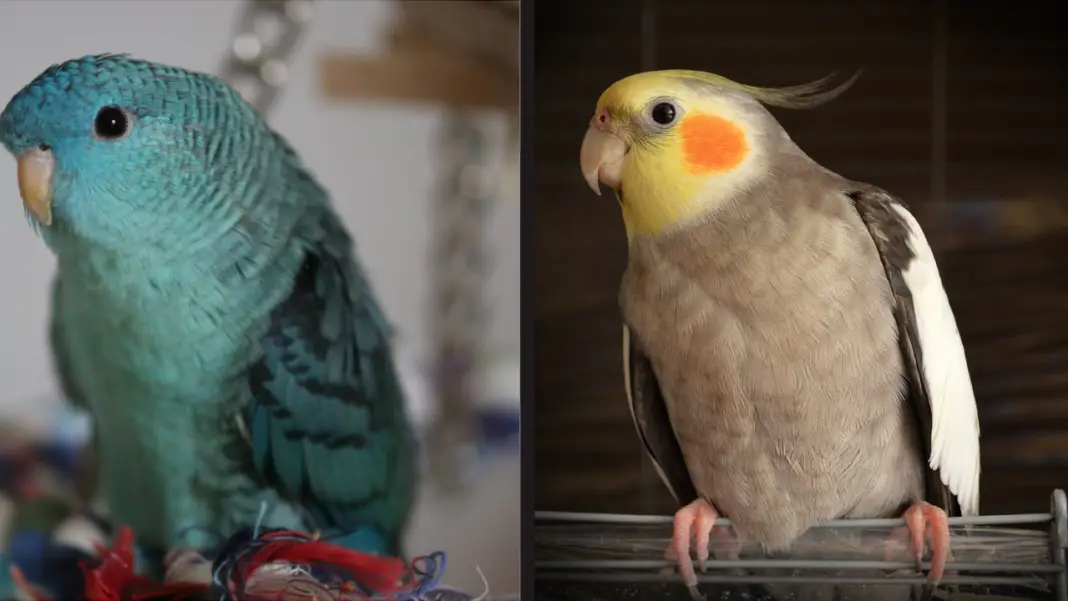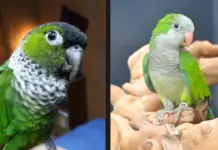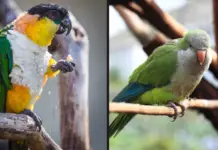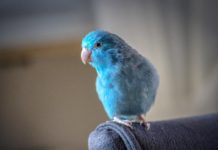Lineolated parakeets (also known as barred parakeets) along with cockatiels have been the most popular companion birds in North American homes for generations.
For a long time, parakeets in general were the most common companion bird in both the US and Canada. However, more recently, they’ve taken the #2 spot behind cockatiels.
You don’t necessarily need to decide between owning a lineolated parakeet or owning a cockatiel. You could own both. Although in case you’re looking to choose only one between the two, this article should help you better understand the difference between a lineolated parakeet and a cockatiel and help you to choose the better bird for you.
While both birds have a number of similarities, there are some notable differences.
Lineolated Parakeets And Cockatiels As Pets
Both lineolated parakeets and cockatiels make for great apartment pets.
Both kinds of birds like to vocalize, although the lineolated parakeet tends to be more chatter. Both birds aren’t so noisy that they’ll disturb the neighbors.
Like the majority of other parrots, lineolated parakeets are quiet all night (given that they have a dark place to sleep).
It’s easy to tame both cockatiels and lineolated parakeets so both can be held in the hand. Both birds have a natural curiosity, and they can both be taught tricks.
When it comes to lineolated parakeets and cockatiels, it’s typically the male that learns to talk well compared to females.
Both species are happy if they have a roomy cage and get an occasional chance to fly free indoors.
The usual advice is that lineolated parakeets are good pets for children, while cockatiels are good pets for older adults, although this isn’t always the case as both birds are good with most people.
Both of these birds don’t need to be taken for walks, and they won’t ever get underfoot with the potential of causing a fall.
What Are The Differences Between Lineolated Parakeets And Cockatiels?
Most people who enjoy keeping birds can have a good experience with either a lineolated parakeet or cockatiel, in some cases, even both, although there are some significant differences between the two.
Size
There is a definite difference in size between lineolated parakeets and cockatiels. Lineolated parakeets are around 6-7 inches.
Cockatiels in North America usually measure around 12-14 inches from the top of their head to the end of their tail feathers.
English budgies which are similar to their American cousins, lineolated parakeets, are usually bigger.
Both English budgies and American lineolated parakeets are the same species of bird. However, the English budgie has been bred to be bigger.
English budgies are around 10 to 12 inches long.
English budgies and cockatiels need bigger cages compared to lineolated parakeets.
They can eat more, too, although the cost of maintaining cockatiels and English budgies isn’t much higher than taking care of a lineolated parakeet.
Energy Levels
Lineolated parakeets love flying, although due to them being a bit stockier than other parakeets, they enjoy walking around just as much.
Outside of their cage, they’ll try to explore everywhere in a room, when given the chance (so it’s important to protect them from any kind of hazard in a room, like ceiling fans, hot stoves, or a commode with the lid up — or any other house pets).
Cockatiels are usually more laid back. They prefer to spend more time sitting and preening. Compared to conures and other parrots, lineolated parakeets or cockatiels are very loud.
Lineolated parakeets are more chatter than cockatiels, and male cockatiels are more vocal than female cockatiels.
If noise is a concern for you, then a female cockatiel would be a better choice.
Talking
Both lineolated parakeets and cockatiels both enjoy talking. Lineolated parakeets tend to imitate words more clearly compared to other pet birds.
Lineolated parakeets also have a larger vocabulary than cockatiels.
While lineolated parakeets have been known for having amazing vocabularies, male cockatiels have a great talent for whistling.
In the wild, whistling is a common way for a male cockatiel to attract a mate. As courtship is quite a long process, they’ll whistle for hours at a time.
If you’re looking for a bird that can whistle tunes over a bird that can talk, then a male cockatiel would defiantly be the better choice.
Cuddliness And Affection
Are you looking for an affectionate and cuddly bird? Many bird owners report that cockatiels are cuddly and affectionate. Cockatiels especially love scratches on the head.
While lineolated parakeets turn out to be cuddly and affectionate too, it’s much more common for them not to be of a touchy-feely temperament.
The best way to enjoy lineolated parakeets is to watch them interacting with each other. Although this isn’t to say you can’t own just one lineolated parakeet. lineolated parakeets are very social with other birds.
In fact, lineolated parakeets are so social that if you keep them with cockatiels (which we previously mentioned was possible), it’s possible that a cockatiel could become annoyed with the lineolated parakeet’s constant invitations to play.
The lineolated parakeet may constantly chase a cockatiel around, even if the cockatiel isn’t interested.
What Are The Demands On Your Time?
Both lineolated parakeets and cockatiels need a lot of attention from their owners.
If you’re a first-time owner, then it’s important to know that if you want to have a single bird that bonds with you, whether it’s a lineolated parakeet or a cockatiel, the price you pay is its constant demands for attention.
If you don’t have a few hours every day to spend time with your bird, then it is better to get them companions so that they can bond with each other while you’re away.
If you want to have one bird, you’ll have a happier experience with a hand-fed bird. This is a bird that was fed by humans when it was still in the nest.
Birds that are hand-fed enjoy human contact more and are comfortable around people.
You’ll get more affection from your bird for the time you spend with them if you can get a hand-fed bird.
Many lineolated parakeet owners say that the only way to get the same kind of bonding from a lineolated parakeet that you would get with a cockatiel is to find a hand-raised bird.
Longevity
In the bird world, typically larger birds live longer than smaller birds. As the cockatiel is slightly larger, they tend to live longer than a lineolated parakeet.
Lineolated parakeets usually live for around 10 years, although they can live up to 20. Cockatiels, when in captivity, live 15-20 years, but can live longer.
Common Origins Of Lineolated Parakeets And Cockatiels
Both lineolated parakeets and cockatiels are birds in the Parrot Family. The lineolated parakeet is native to Central and South America, whereas cockatiels are found in the wild in Australia.
It’s likely that one of the main reasons both lineolated parakeets and cockatiels are enormously popular pets is that they can do well even when their owners aren’t fully able to care for them, compared to other more demanding birds.
Lineolated parakeets and cockatiels thrive on a diet of formulated pellets, seeds, a few vegetables, and fresh water.
While they will eat seeds, they won’t thrive on a diet of just seeds and water.
Both lineolated parakeets and cockatiels continue to be active and friendly even when they are provided with less than ideal living conditions.
It wouldn’t be fair to think of either bird as a “starter bird,” as that would imply that their owners would abandon them if they could, better put they are birds that can do well even if with owners that are new to taking care of pets.








